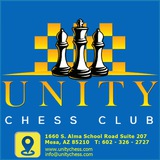This desperate attempt at counterplay does not give any chances – the advance of the pawn is not supported by the white pieces. Black reacts in the simplest possible way, keeping the position closed, which suits him.
The queen alone cannot give mate, but it was hard to recommend anything to White – Black is already prepared to break in down the c-file.
31...gxh6 32.Qxh6 Rc7 33.0-0-0 Nf2 34.Rg1 Rg7 35.Be1 Nd3+ 36.Kd2 Nxe1 37.Kxe1 Qe4 38.Kf2 cxd4 39.cxd4
Unity Chess Club
Michael Adams 2723 Teimour Radjabov 2644 Aix-les-Bains 2003 White to move
The position is quite non-standard, with both kings in the centre. But whilst White can castle by hand, and evacuate his king to the kingside, it is harder for Black to find a safe home for his king. This is the main thing that defines White’s advantage. With his next move, White ensures himself a static advantage.
Black cannot bring his bishop out to a6 and it is impossible to get his pieces out at all. This means that sooner or later, he will have to advance the d-pawn, after which his pawn structure will lose its solidity.
Here, the rook exerts strong pressure on the open file. In open positions, such an approach is usually more effective than building pressure on some weakness or other. So this move is stronger than 20.Rhc1, for example.
The most technical. The king moves to a safe zone, and Black will inevitably come under an attack.
Unity Chess Club
Leonid Stein Lubomir Kavalek Caracas 1970 White to move
All of Black’s hopes of freeing his position are bound up with the advance d6-d5. White’s next few moves are directed at preventing this:
